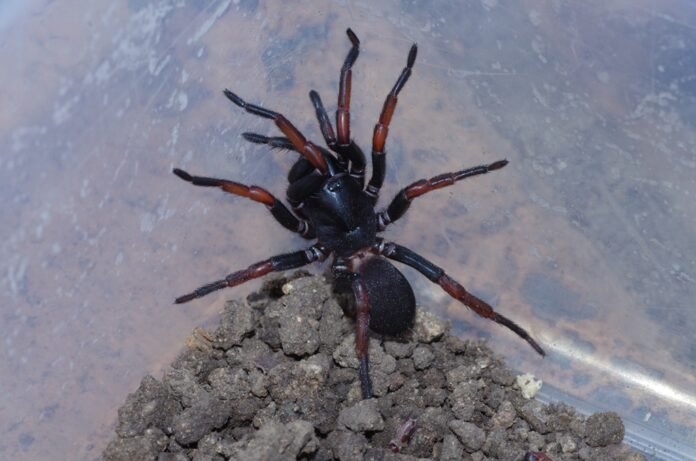A two-year scientific investigation into one of Australia’s most elusive and diverse spider groups has yielded remarkable results: 55 species of wishbone spiders, all previously unknown to science, have been formally described by researchers from Queensland Museum, the Western Australian Museum, and the University of Western Australia.
The study, focusing on the genus Aname—commonly known as wishbone spiders—was published in the European Journal of Taxonomy and represents one of the largest taxonomic revisions of Australian spiders in recent years.
A Web of Discovery
Wishbone spiders, named for the Y-shaped burrows they create underground, belong to the mygalomorph group of spiders, which also includes tarantulas and trapdoor spiders. The newly described species hail from across subtropical and tropical regions of eastern Australia, stretching from northern New South Wales to Cape York Peninsula.
The Aname genus has long fascinated arachnologists due to its diversity and distinctive lifestyle. These spiders are typically ground-dwelling and live in silk-lined burrows that may feature hidden escape routes. Covered in bronze, silver, or gold iridescent hairs, they are as visually striking as they are biologically fascinating.
READ MORE: Stonefish Toxin Shows Promise in Combating Livestock Parasites
Lead author of the study, Dr. Jeremy Wilson, began his work at Queensland Museum before moving to the Western Australian Museum and the University of Western Australia. Over 2.5 years, he and his team have described a total of 84 new Aname species, including the 55 announced in this study.
Behind the Science: Fieldwork and DNA
According to Dr. Wilson, the extensive fieldwork in Queensland and meticulous laboratory research were key to uncovering this hidden biodiversity.
“We made some amazing observations about the burrowing behavior of these secretive spiders on two major field trips in Queensland,” said Dr. Wilson. “In the lab, we identified differences in their physical appearance and even in their DNA.”
The research team used a combination of classical morphological study, live specimen observation, burrow analysis, and molecular phylogenetics to distinguish species. The inclusion of 131 new COI (cytochrome oxidase I) DNA barcodes significantly expanded the genetic understanding of the genus, making this one of the most comprehensive studies of mygalomorph spiders to date.
“Despite this high number of species described, about 60% of Aname species remain undocumented,” Dr. Wilson added. “Many are likely still hidden in remote or arid regions, meaning we’ve only scratched the surface of this group’s full diversity.”
The Burrowing Masters of the Outback
Wishbone spiders live out of sight, constructing their elaborate burrows beneath the soil. Their preferred environments range from forest floors to arid plains, and their silk-lined tunnels can run impressively deep. Many of these burrows feature secondary, hidden exits thought to serve as emergency escape routes—an evolutionary adaptation to evade predators.
In addition to the aesthetic appeal of their iridescent coloring, the spiders’ behaviors and burrow designs offer valuable insights into their ecological roles and evolutionary history.
Dr. Michael Rix, Queensland Museum’s Principal Scientist and Curator of Arachnology, co-authored the paper and underscored the significance of combining traditional taxonomy with molecular analysis.
Honoring Supporters Through Science
Among the 55 newly described species are Aname mulgana, found throughout the Mulga Lands of southwestern Queensland, and Aname eddieorum, named in honor of the Eddie family who operate the ecological consultancy Boobook.
Another, Aname lawrenceae, honors Melinda Lawrence, who supported the research in her role as Project Manager.
In addition to the new discoveries, 10 previously described species were redescribed and clarified, including Aname barrema, Aname blackdownensis, and Aname camara, adding clarity to existing taxonomic records.
More Than Just Spiders: A Biodiversity Mission
Queensland Museum CEO Dr. Jim Thompson emphasized the broader importance of research projects like this one.
“This study is a reminder of how much there is still to learn about our unique biodiversity,” said Dr. Thompson. “Hosting Dr. Jeremy Wilson during the first year of this project was a privilege. His research not only added new specimens to the State Collection but also unlocked parts of our collections that had remained unexamined for decades.”
Dr. Thompson also noted the long-term value of such research: “These new specimens and taxonomic descriptions will provide a foundation for future biodiversity work across the country.”
With an estimated 300 species of Aname believed to exist across mainland Australia, this study brings the known total closer to 40% of the genus. However, researchers stress the need for ongoing exploration and funding.
“Fieldwork is essential,” said Dr. Wilson. “Many of these spiders live in isolated or fragile ecosystems that are vulnerable to environmental changes. We need to document and understand them before those habitats are altered or lost.”
Dr. Rix added, “This work highlights the need for sustained investment in taxonomy and biodiversity research, especially in under-studied regions.”
Looking Forward
The newly published study is the first in a series of major taxonomic revisions expected to emerge from the researchers’ efforts. The team aims to continue exploring remote regions and applying cutting-edge technologies to further catalogue Australia’s stunning arachnid diversity.
“Our work is far from over,” Dr. Wilson said. “This study is just the beginning of what we hope will be a transformative effort to document Australia’s mygalomorph fauna. There’s an entire hidden world beneath our feet, and wishbone spiders are just one part of it.”
As Australia continues to reveal the secrets of its natural world, the wishbone spider’s story stands as a testament to the power of scientific curiosity, collaboration, and the importance of preserving the country’s unique and delicate ecosystems.
